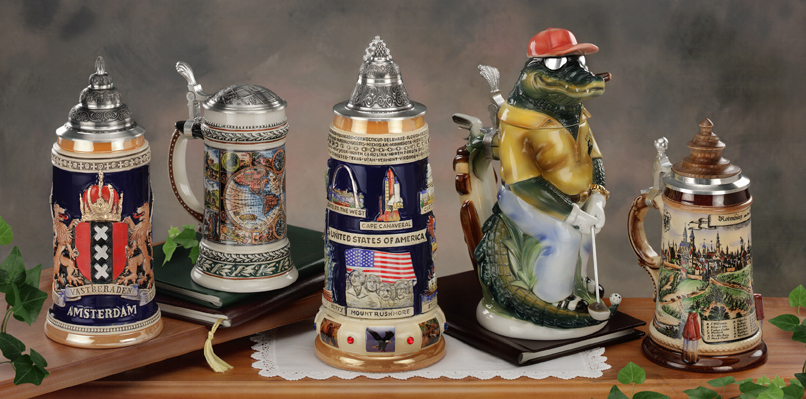Table of Contents
*This post may contain affiliate links. As an Amazon Associate we earn from qualifying purchases.
They say it’s not what you drive, but how you drive it. Sure, but having a sweet ride doesn’t hurt, and the same goes for drinking beer. There’s some charm to pounding brewskis from a red Solo cup, but when you grow up you have to drink from a vessel worthy of the fine brew you can (hopefully) afford now that you have graduated. The finest facilitators of your alcoholic delight are the beer steins, the pinnacle of brew delivery systems.
Beer steins are, in layman’s terms, really big mugs. But they are so much more than that. Exquisitely crafted and decorated, beer steins are works of art unto themselves. They represent a rich tradition stretching back centuries to the very beginnings of beer as we know it. Also, they hold a whole lot of beer.
Let’s explore the origins of these good time enabling quaffing devices and see how they are such a big part of beer culture. Then we can see some of the different kinds out there and what kinds you can get your hands on. Even if you don’t drink, you can get one of these beautiful and culturally important pieces just to decorate your home; they are that cool.
The Stein
The word “stein” is a bit of a misnomer. In Germany, the birthplace of the stein, stein simply means stone. The original German word for what we consider a stein was steinzeug, which means stoneware. The words steinzeugkrug and steinkrug are also used, meaning stoneware jug and stone jug respectively.
This nomenclature is attributed to the materials that steins were first made from. Originally, clay and other earthenware were the primary materials used in stein production because they could be easily decorated, lasted longer and were relatively cheap. However, the steins can be made of wood, glass, pewter, silver, porcelain or crystal glass.

Now there’s a lot of words that mean drinking vessels, so here are few more terms defined to clear up confusion:
- Tankard: Technically a stein, depending on who you ask. However, tankards are only made of pewter or silver according to purists. Still, people all over the world use the words tankard and stein interchangeably, and no one has been arrested, yet.
- Mug: A general term for any drinking cup with a handle and no lid. So some, but not all steins could be considered mugs, as some steins have lids. Additionally, some mugs, but not all are steins. Don’t go claiming your coffee mug is a German beer drinking chalice because no one will believe you. Keep drinking beer out of it though; there’s nothing wrong with that at all.
The Beginning

Modern steins as we know them today have their origins in medieval Germany. Certainly, there were earthenware mugs from which you could imbibe beer before this period, but the stein’s unique features came about in this period. The stein’s life begins with death.
In the late 14th century, the bubonic plague ravaged Europe. The Black Death killed a third of the continent’s entire population, and despite the Catholic Church’s insistence that prayer would save them, the survivors quickly learned that the plague hit unsanitary places much harder than cleaner ones.
The German nobility, therefore, placed many laws into effect to keep their lands clean, including predecessors the famous and still enforced Reinheitsgebot, the “German beer purity laws” that set parameters on what can go into German beer.
Another of the regulations that nobles put into place was a lid requirement on drinking vessels. The lid prevented infected insects and other unclean material from getting into drinks to reduce the risk of plague spreading. This design necessity put a more serious focus on mug construction and brought about the trend of lidded mugs that persists today.
After the plague had passed, there were many fewer workers and laborers to work the fields and cities. Therefore, the lower classes could demand higher wages due to the labor shortage. Higher wages meant that these workers could spend disposable income on small luxuries, such as elaborately decorated personal drinking vessels. Thus, the stein was born.
Drinking beer was an integral part of Medieval European peasant life, as it was a cleaner drink than water and contained carbs and calories to keep you working. Some laborers were even paid in barrels of beer for their work. Since beer was such an essential part of their lives, a lot of thought went into what they drank it from. The tradition has persisted, and central Europeans, as well as their global diasporas, keep it alive to this day.
The Stein Evolves

Crafting steins had become an art form, like other forms of pottery and sculpture. As time went on, artists looked back at the Medieval and Renaissance periods for inspiration and decorated steins with famous battles, legends, and historical figures. Steins stopped being only a drinking implement, but also works of art meant simply to be observed and enjoyed.
The stein never stopped evolving, and soon crafters were making them out of pewter, carved wood and precious metals like silver. The nobles got in on the stein game and made them even more elaborate and exotic. Wealthy patrons would commision steins in their honor, depicting their achievements and holdings. In some museums you can find enormous steins, elaborately and meticulously decorated, that can hold upwards of 32 liters (8.45 gallons)!
Beginning in the 19th century, glassware techniques and technology progressed to the point that steins could be reliable, quickly and cheaply made from glass. This opened up a whole new world of artistry due to complex glass blowing and color variations. Instead of simply copying the past, artists began to create more original works. Gone were historicist steins, to be replaced by modern landscapes and social scenes, as well as military commemorations.
By the late 1800s, it became clear that glass drinking vessels were more hygienic than stone ones over time. Earthenware is porous, to some degree, so bacteria buildup can become an issue. Glass is much easier to clean, and you can see where any residue and buildup might be. Because of this fact, Oktoberfest switched to glass steins and has continued to use them for over a hundred years. They want their revelers throwing up for the right reasons.
Steins Today
As German immigrants spread to the New World, they took their steins with them. The United States has become the top consumer of beer steins in the world and collecting antique steins has become a popular hobby. Ceramarte, a Brazilian company, has become the largest producer of ceramic beer steins in the world.
With the rise of automation and beer popularity, owning and drinking from beer steins is now a global practice. Even if you can’t commission a six-foot-tall beer stein commemorating your military conquests, you can still get one for yourself for a decent price.

How to Get One for Yourself
There are several ways you can get your hands on a beer stein of varying difficulty and cost. It all depends on what you want and what you are willing to pay.
Authentic Antiques
If you want to go the purest route, you’ll want an authentic German beer stein. Due to their historical popularity, you can find genuine antiques from the Fatherland for a decent price at most large antique merchants. They were widespread enough that there are many left over, even from before the 20th century. Maybe keep these as showpieces though, drinking from them might not be the best idea unless you really want to show off.
Custom Beer Steins
Just because you aren’t a Bavarian noble, it doesn’t mean you can’t get a unique stein just for you. Many online vendors offer custom beer steins with your name, image, or whatever else you want on it. They are likely machine made, but that helps keep the cost down. There are undoubtedly artisans out there still hand making steins and taking commissions, but they are a bit more difficult to find.
Store Bought Beer Steins
By far, the cheapest option for getting your own beer stein is finding a premade, machine crafted beer stein. Sure, they aren’t the most authentic beer steins around, but you’ll be laughing at those contrarian hipsters giving you grief when you are still able to afford the good beer and they are stuck drinking generic beer out of the antique stein they paid through the nose to get.
Online vendors offer reasonably priced steins, as do some retail stores. You can even find some steins for sale at beer festivals. Some big breweries even put out their own steins to reinforce their brand. If it’s your thing, you can get Budweiser beer steins to rep your loyalty. You might not be able to afford the fancy antiques, but that should not stop you from drinking beer the way it was meant to be drunk: out of beer stein that’s big enough to be a weapon but beautiful enough to be art.

